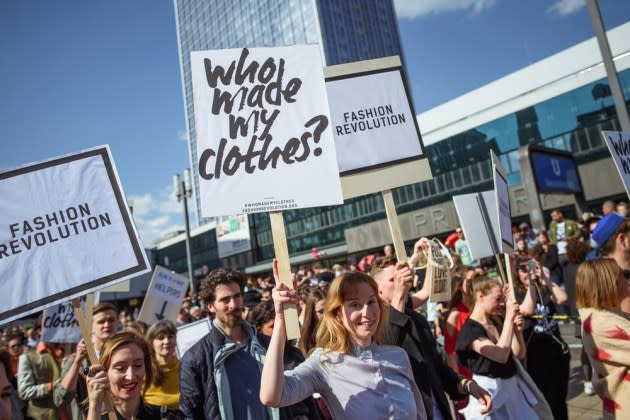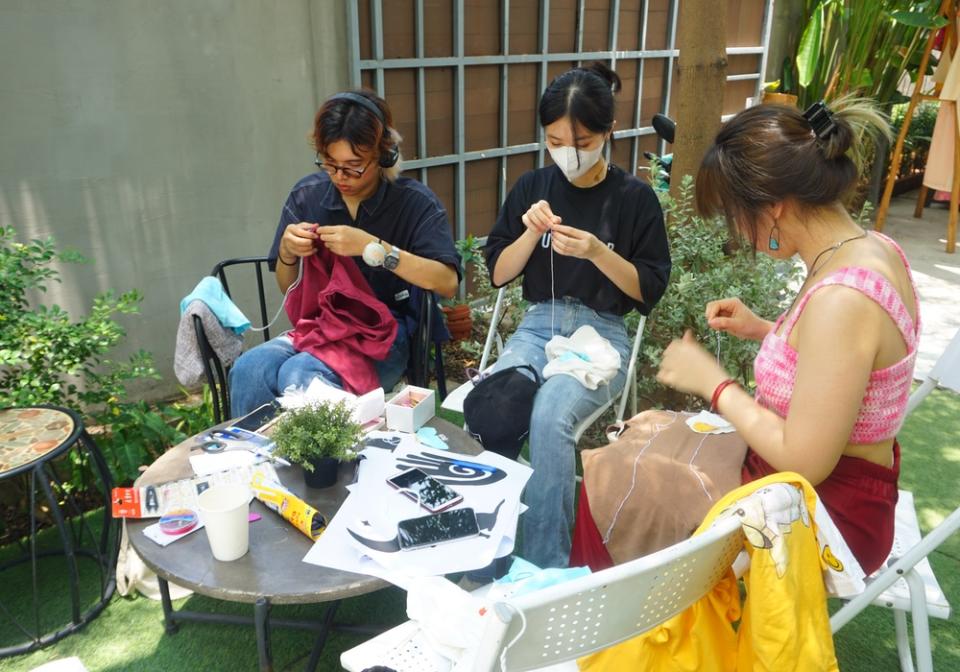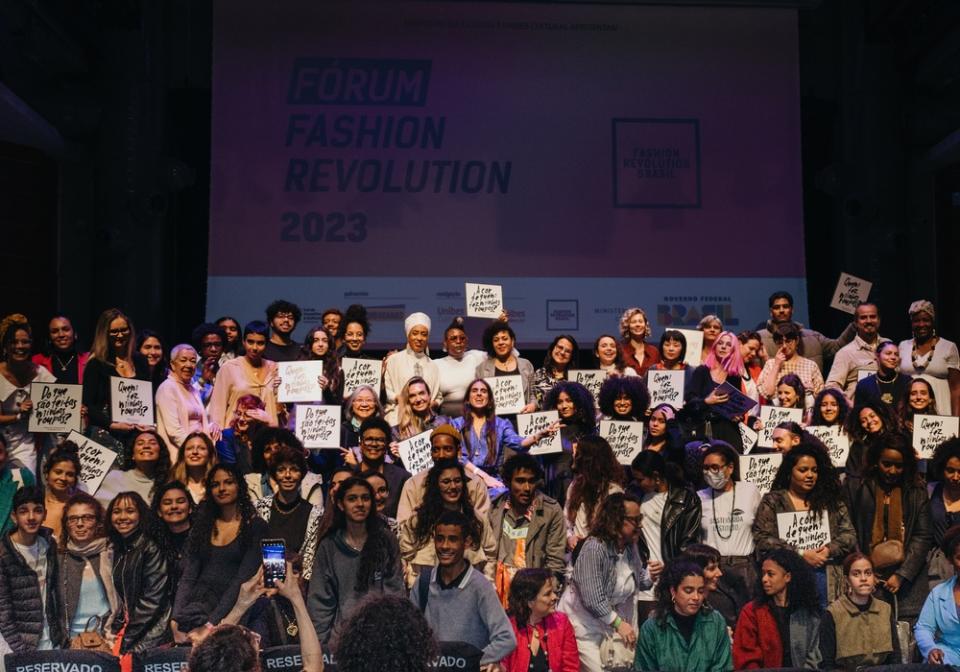10 Years After ‘Who Made My Clothes,’ Is It Time for a New Question?

Fashion Revolution kicked off on April 24, 2014, with one deceptively simple question: “Who made my clothes”?
It was a straightforward inquiry, but one that few people at the time considered. Exactly a year before, a nine-story multi-factory building outside the Bangladeshi capital of Dhaka was buckling under the weight of its illegally constructed upper floors. When a sudden power outage resulted in several heavy generators turning on at once, the crack-stricken Rana Plaza shuddered, then collapsed, killing 1,134 garment workers and injuring and maiming thousands more.
More from Sourcing Journal
In the following days, labor activists had to sort through the bloodied rubble to find labels and production orders from brands such as Benetton, JCPenney, Mango and Walmart, many of which had initially denied sourcing from the building. As it turned out, even fashion companies couldn’t answer the grassroots movement’s question.
But the iconic slogan and logotype that turned masses of “Who made my clothes?” signs on the picket line and across social media into a rallying cry almost didn’t happen, said Mel Watt who coordinates the annual Fashion Revolution Week, an expansion of the original Fashion Revolution Day. The inaugural hashtag, #insideout, had encouraged people to post pictures of themselves with their clothing labels in front as a plea for corporate transparency. This was supposed to be the theme of the first Fashion Revolution Day, too.
“Then, in my opinion, a very great Disney animation came out in the same name and we changed it,” Watt said. “I always think what if the name hadn’t changed? I don’t think it quite would have caught the mass attention in the way that it did.” Fun fact: the first iteration of the new motto was “Who made your clothes?” Making it a first-person directive came later.
How to be a fashion revolutionary
Credit Orsola de Castro and Carry Somers, two U.K. designers who founded Fashion Revolution but have since stepped back, for jump-starting one of the most recognizable fashion advocacy organizations, now a global network with nearly 100 countries across six continents. It was de Castro and designer Heather Knight who came up with the branding and visual communication that would define the movement over its decade of existence. “Who made my clothes?”—rendered distinctly in the Zombie Checklist Alpha typeface by Max Infeld—also got to the crux of the fashion industry’s problem.
“It was about choosing the simplest question that brands would find impossible to answer, but also a question that is very simple, but so many of us hadn’t thought to ask ourselves,” said Watt, who joined Fashion Revolution as a full-time employee in 2023. “When I was asked that question, I almost felt stupid that I hadn’t considered it before and it was the foundation of my fashion activist journey. Inside out: it was a great campaign, but would it have had the same impact? I’m not sure.”
The fact that the branding was open source, as are all of Fashion Revolution’s resources today, helped propagate the message, too. “Who made my clothes?” is not only readily translatable into different languages but also boundlessly adaptable: Pictures spread across Facebook, Instagram and X show people raising placards with “Who made my yarn?” or “Who made my shoes?” Some garment workers have responded in kind, emerging from their relative pre-social media anonymity and posing with signs that say “I made your clothes.”
“It’s really to invite as many people as possible to take part in the movement,” Watt said. “Whether it’s displayed on a shop window or maybe a university pinboard on social media. I think it’s been so instrumental in getting the message out in as many diverse places as possible. And I think it also speaks to the creativity of the movement. In many ways, it’s taken off on a life on its own to go beyond Fashion Revolution and speak to new audiences. And I think that’s wonderful.”
Fashion Revolution is toasting its 10th year doing what it’s always done: mobilizing hundreds of thousands of what it dubs “global citizens” to reevaluate their relationship with consumption, engage with policymakers to push for legislative change and demand greater transparency and fair play from the biggest names in fashion. Though its central node operates in London, the organization functions around a decentralized structure, meaning that country groups govern themselves according to a shared set of guidelines and principles, albeit with the support of the U.K. head office.
“Seeing the Fashion Revolution global network teams come together and work together is all I ever wanted for our 10th anniversary,” said de Castro in a rare statement since leaving her position as director in late 2022. “We can only make lasting changes if we join all our perspectives, and the Fashion Revolution’s movement strength [is] the differences that unite us.”

For Liv Simpliciano, Fashion Revolution’s policy and research manager and a three-year vet of the nonprofit, every day is Fashion Revolution Day, so while the anniversary is a “nice moment of celebration,” it’s also a regular workweek.
Even so, there were also events aplenty: A “Who made my clothes?” exhibition in Tokyo; a repair café in Morangis, France; a slow fashion book club in London; an installation about the “true costs of fashion” in Poland; a denim recycling workshop in Buenos Aires; a Rana Plaza remembrance ceremony in Singapore; a clothing swap in Bengaluru, India; a fabric donation drive in Vancouver, Canada. Team Scotland celebrated by lobbying legislators for a more sustainable fashion policy. Online, Zoom sessions taught “the next generation of activists” how to be storytellers, campaigners and community organizers. Worldwide, Fashion Revolution coordinated its first global mend-in-public day, a practically radical act in a world of disposable fashion.
“It’s really nice to be reminded of how we’re all connected, and I think that’s a good source of energy,” Simpliciano said. “There’s so many people involved in this movement that I will never see or meet, so it’s always so surprising to hear how Fashion Revolution Week impacts people globally and how they engage.”
Simpliciano also spearheads the Fashion Transparency Index, which Fashion Revolution publishes every year to rank brands based on their public disclosure of social and environmental policies, practices and—equally important—impact. Her work there has been nothing short of an honor, she said.
“It has been so transformative in helping citizens to understand why these issues in the fashion industry are important,” she said. “We know that it’s being used by investors, by the brands themselves. I think a big thing to be proud of is the engagement. Last year, we had 62 percent participation [from brands]. Having them take to heart our methodology, to really see that influence has been really rewarding.”
That marked shift in transparency, a decade after Rana Plaza, while by no means “good enough,” is still something to celebrate, Simpliciano said. More than half of fashion companies now disclose their first-tier supplier lists, versus next to nothing in 2014. Even luxury houses that refused to be anything but closed-lipped about their supply chains have opened up. Fashion Revolution won’t take full claim for the change but it’s still a “big force” behind it, she said.
#aCorDeQuemFezMinhasRoupas
Isabella Luglio is the manager of the Brazilian version of the Fashion Transparency Index. Before Fashion Revolution Brazil reared its head, awareness of the industry’s manifold issues in the South American nation was “minimal,” she said. The difference today, however, is “huge,” with its 70-plus student ambassadors taking an especially active role.
Having a compelling look and snappy slogans can help win over the younger generation where dour messaging might turn it off, she said. Accessibility, in other words, is critical.
“Sometimes in the past, NGOs and movements that were dealing with really strong, complex issues, they tend to have like a more serious image,” Luglio said. “And by having this cool branding, we are able to impact even more because we remove a little bit of the skepticism of the people approaching the serious issues.”
This was the tack that Fashion Revolution took with Good Clothes, Fair Pay, a campaign that called for living wage legislation across the entire sector. By the end of its deadline, the organization was able to muster a quarter of the 1 million EU citizen signatures that would trigger a right to request to the European Commission. Underpinned by eye-grabbing colors and Instagram-friendly illustrations—there were even jauntily swaying gifs that said “I support the Good Clothes, Fair Pay campaign”—the initiative became the largest living wage effort in fashion.
Meanwhile, it’s localization that can make issues more real to people being targeted, Luglio said. In 2021, for instance, Fashion Revolution Brazil added the hashtag #aCorDeQuemFezMinhasRoupas, which translates into “the color of who made my clothes.” No other country has anything similar.
“Brazilian society is made up of more than 56 percent of people who are non-white,” Luglio said. “And in corporations, at the CEO level, the directors’ level, we only see white males. So we thought that we needed to bring this question up because we know that here in Brazil, people who are making our clothes are women and non-white women. So this was powerful for us.”

Fashion advocacy is by no means easy, Simpliciano said. Despite its breadth of reach, funding and resources are an evergreen issue. It’s also an unfortunate truism that civil society is expected to work for free.
“We are facing lobbies that are incredibly powerful that have unlimited resources,” she said. “Activists are up against a huge power imbalance that is dominated by pro-business lobbies. Because of this, we sometimes cannot, to the same extent, push our advocacy demands and translate them into legislation.”
At the same time, what’s at stake is the future of the planet. People’s trust in governance, Simpliciano said, is at an all-time low with “people pulling back the curtain and waking up to the realities of injustice, losing faith in their judicial systems and pouring into the streets in their millions.”
“On top of this, we have a worrying rise in far-right movements globally,” she said. “So, while we see some progress being made when it comes to regulating the fashion industry, I fear that the environment to enact that change is being threatened, as is the right to protest.”
While it’s easy to get mired in despair, the “cause for hope and action” and the need for community has never been clearer, Simpliciano added. That’s what keeps her going.
Watt said that “Who made my clothes?” may have channeled the public outrage over Rana Plaza into targeted and timely action that exposed the “scale of injustice” in fashion production, but from a citizen level, it’s also a way to inspire consumers to think a little deeper about what they wear “without inciting shame or pointing fingers,” which has been key to getting people involved in fashion activism over the years.
A decade on, it’s also important to acknowledge that knowing who made our clothes is not enough, she said.
“That is a question that has been repeatedly answered but that’s not where our questions stop,” Watt said. In Chile, where the Atacama Desert has become the equivalent of a fashion graveyard, for instance, one question has been “Where did my clothes end up?” As concerns about toxic chemicals mount, another might be “What’s in my clothes?” To bring more attention to farmers, one might ask, “Who grew my fabric?”
As Fashion Revolution enters its its next decade, it has many follow-up questions that go beyond the basic supply chain visibility that has become table stakes in the face of growing due diligence legislation.
“We want to know if our garment workers are being paid a living wage,” Watt said. “We want to know what volume of clothing brands produce a year, something that in 2023, only 12 percent of brands disclose and we know is the elephant in the room. We also want to know what are the industry’s plans to transition into a fossil-free industry. And so I’d say those three areas are definitely going to be guiding our campaigning work and you will be seeing a new question from us very, very soon.”

